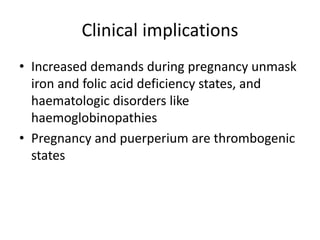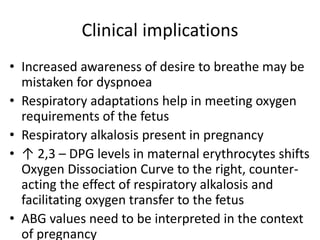Physiological changes in pregnancy.ppt
- 1. Physiological changes in pregnancy
- 2. Maternal adaptations to pregnancy Profound anatomical, physiological and biochemical changes occur during pregnancy Purpose is to support growth of the fetus and prepare the mother for delivery and lactation Some of the adaptations may be considered abnormal if the patient was not pregnant Normal adaptations can be misinterpreted as disease Pregnancy adaptations can unmask or worsen pre-existing disease
- 3. Uterine changes Progressive uterine enlargement Helps in gestational dating Helps in assessing fetal growth Occurs in ectopic pregnancy also Contributes to pedal edema by occluding venous return Supine hypotension Due to vena caval compression Occurs in women with poor collateral circulation
- 4. Haemodynamic changes Increased intra-vascular volume Blood volume ○ Increased by 40 - 45% ( appx 1.5 litres) Plasma volume ○ Increased by 50% ( appx 1.2 litres) RBC volume ○ Increased by 20 – 30 % ( appx 250 – 400 ml) Increased cardiac output Increased by 40 – 50% ( appx 1.8 litres / min)
- 5. Haemodynamic changes • Decreased peripheral vascular resistance – Decreased by 20 – 25% • Decreased pulmonary vascular resistance – Decreased by 30 – 35% • Decreased colloid oncotic pressure – Decreased by 10 – 15% from 20.8 mm of Hg to 18 mm of Hg • Increased heart rate – Increased by 15 – 20% • Increased regional blood flow – Uterine 750 ml /min ; Renal 1200 ml / min ; Cutaneous 500ml / min
- 6. Clinical Implications • Increased cardiac workload • Misinterpretation as heart disease • Aggravation of pre-existing disease • Susceptibility to Pulmonary edema – Pre eclampsia – Heart disease
- 7. Symptoms & Signs which mimic Heart disease during pregnancy • Breathlessness • Pedal oedema • Easy fatigability • Palpitations • Orthopnoea • Soft systolic murmurs • Continuous parasternal murmurs • Third heart sound • Displacement of the heart
- 8. Effects of pregnancy on heart disease • Precipitation of cardiac failure – Aggravating factors • Maternal age • Arrhythmias • Anaemia • Pre eclampsia • Multifetal gestation • Activity • Infection • Anxiety • Increased coagulability of blood • Risk of infective endocarditis during labour / termination of pregnancy
- 9. Haematologic changes • Physiologic haemodilution • Neutrophilia • Marked leukocytosis in labour • ESR ↑ • Complement C3 and C4 elevated significantly • Increased clotting factors ( V, VII,VIII, IX, X, XII and Fibrinogen) • Impaired fibrinolysis through increase in Plasminogen activator inhibitors 1 and 2 (PAI-1/ PAI-2) • Increased platelet size
- 10. Clinical implications • Increased demands during pregnancy unmask iron and folic acid deficiency states, and haematologic disorders like haemoglobinopathies • Pregnancy and puerperium are thrombogenic states
- 11. Metabolic changes • Water retention approx 6.5 litres • Increased plasma lipids and lipoproteins – Serum cholestrol ↑ 40% – Serum triglycerides ↑ 50% • Altered plasma proteins – Albumin ↓ to ~ 3 gm% (Non pregnant ~ 4.3 gm%) – Globulin ↑ to ~ 3 gm% (Non pregnant ~ 2.6 gm%) – A:G ratio 1 : 1 (Non pregnant 1.7 : 1) • Altered pH – 7.45 (Non pregnant 7.4) • Altered plasma bicarbonate – 22 m mol /L (Non pregnant 26 m mol /L)
- 12. Respiratory system • Increased awareness of a desire to breathe (Progesterone induced central effect) • Diaphragm rises by ~ 4 cm. Transverse diameter of thoracic cage ↑ by ~ 2 cm • Functional residual capacity ↓ to ~ 1500 ml (Non pregnant ~ 2000 ml) • Respiratory rate unchanged • ↑ tidal volume ~ 700 ml (Non pregnant ~ 500ml) • 40 % ↑ minute ventilation ~ 10.5 L (Non pregnant 7.5 L) • Respiratory alkalosis pCO ~ 28 mm Hg (Non
- 13. Clinical implications • Increased awareness of desire to breathe may be mistaken for dyspnoea • Respiratory adaptations help in meeting oxygen requirements of the fetus • Respiratory alkalosis present in pregnancy • ↑ 2,3 – DPG levels in maternal erythrocytes shifts Oxygen Dissociation Curve to the right, counter- acting the effect of respiratory alkalosis and facilitating oxygen transfer to the fetus • ABG values need to be interpreted in the context of pregnancy
- 14. Urinary system • Dilatation of renal pelvis, calyces and ureters because of hormonal and mechanical influences • GFR ↑ 50% (Non pregnant 120 ml / min) • Renal plasma flow ↑ 45 – 50% • ↓ Serum creatinine & Blood urea levels • Serum osmolality ↓ by ~ 10 m Osm / Kg (Non pregnant 280 – 300 m Osm / Kg)
- 15. Clinical implications • Hydronephrosis and hydroureter during pregnancy should not be mistaken for obstructive uropathy – These changes are more marked on the right side – These changes may take upto 12 weeks to resolve post- partum) • Upper UTIs are more virulent • Nocturia more likely as dependant edema fluid is mobilized and excreted by the kidney • ↑ frequency due to mechanical bladder compression • S. creatinine > 0.8 mg% and Blood urea > 30 mg%
- 16. Gastro – intestinal system • Displacement of organs – Appendix displaced upwards and laterally • ↓ gastric empyting • ↓ tone of gastro-esophageal sphincter • Delayed intestinal transit time • Altered liver function tests – ↑ alkaline phosphatase (Non pregnant 21 – 91 IU/L or 4 – 13 KA units) – ↓ plasma albumin – ↑ plasma globulin • Hyperemia and softening of gums
- 17. Clinical implications • Atypical symptoms and signs of appendicitis during pregnancy. Risk of peritonitis ↑ • Major risk of regurgitation and acid aspiration during GA • ↑ incidence of reflux oesophagitis, constipation and haemmorhoids during pregnancy • Bleeding from gums during pregnancy while brushing
- 18. Endocrine system • ↑ serum Prolactin ~ 150 ng / ml (Non pregnant < 20 ng / ml) • ↑ TBG • ↑ Total T3 (Non pregnant 80 -100 ng / dl) and T4 (Non pregnant 4 -12 μgm /dl) • TSH levels unchanged except for slight decrease in I trimester ( normal range < 5 μIU/ml or < 5 mIU / L) • ↑ BMR by 25 % can be attributed to fetal
- 19. Thank you


















